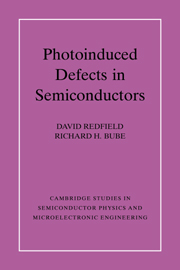Book contents
- Frontmatter
- Contents
- Preface
- 1 Introduction: Metastable Defects
- 2 III–V Compounds: DX and EL2 Centers
- 3 Other Crystalline Materials
- 4 Hydrogenated Amorphous Silicon: Properties of Defects
- 5 Hydrogenated Amorphous Silicon: Photoinduced Defect Kinetics and Processes
- 6 Other Amorphous Semiconductors
- 7 Photoinduced Defects in Devices
- References
- Index
Preface
Published online by Cambridge University Press: 15 December 2009
- Frontmatter
- Contents
- Preface
- 1 Introduction: Metastable Defects
- 2 III–V Compounds: DX and EL2 Centers
- 3 Other Crystalline Materials
- 4 Hydrogenated Amorphous Silicon: Properties of Defects
- 5 Hydrogenated Amorphous Silicon: Photoinduced Defect Kinetics and Processes
- 6 Other Amorphous Semiconductors
- 7 Photoinduced Defects in Devices
- References
- Index
Summary
Over the past few decades a fascinating revolution has taken place with regard to the way that defects in semiconductors and their properties are regarded. Traditional understandings of a variety of effects have used models of isolated point defects with fixed properties, operating independently in the matrix of the solid, and describable in terms of one-electron energy bands and defect levels. More recently we have come to realize that this classic picture of a simple defect with fixed properties may be the exception – that in real semiconductors there is a wide variety of interactions between defects with deep energy levels and the lattice that leads to variations in local atomic configurations comprising the defect, and in some cases to complexes between defects. The central distinguishing feature of most of the defect processes of interest is that they inextricably couple the electronic system and local structural configurations. Consequently, processes involving these defects cannot be fully described by either electronic transitions or defect states alone.
Some of these new configurations are relatively stable, but many others are not: They can be brought into metastable existence in the solid by the action of photoexcitation, other high-energy excitation, injection of excess carriers, and/or thermal energy, and they can be removed once again by thermal or optical anneal that returns them to their ground state. The metastability of their existence and the radical changes in electronic properties that can exist between their ground state and metastable state provide interesting new possibilities for semiconductors, but often they also provide mechanisms for instability and degradation that handicap the applications of semiconductors.
- Type
- Chapter
- Information
- Photo-induced Defects in Semiconductors , pp. ix - xPublisher: Cambridge University PressPrint publication year: 1996



